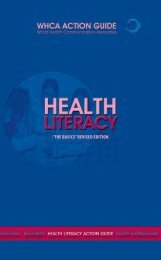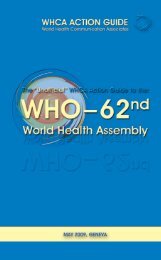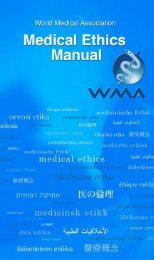Part 1 'the basics' - World Health Communication Associates
Part 1 'the basics' - World Health Communication Associates
Part 1 'the basics' - World Health Communication Associates
You also want an ePaper? Increase the reach of your titles
YUMPU automatically turns print PDFs into web optimized ePapers that Google loves.
SECTION 1: WHAT IS HEALTH LITERACy?<br />
This guide defines health literacy as “The capacity to obtain, interpret and<br />
understand basic health information and services and the competence to use<br />
such information and services to enhance health.”<br />
(Ratzan and Parker 2000; IOM 2004).<br />
However, this is not just determined by an individual’s basic literacy skills, but is<br />
also defined by their interaction (or alignment) with the systems within which they<br />
need to function (see Figure 1). <strong>Health</strong> literacy varies by context and setting. It is<br />
dependent on individual and system factors. This includes both user and provider<br />
communication skills and knowledge of health topics, culture, and the demands of<br />
the health care, public health and other relevant systems and settings where people<br />
obtain health information (<strong>Health</strong>y People 2010). When these services or systems<br />
require knowledge or a language level that is too high for the user, health will suffer.<br />
Skills/Abilities<br />
health<br />
literac y<br />
Figure 1. <strong>Health</strong> Literacy Framework (Parker 2009, pers.comm.)<br />
Over 300 studies in the US and UK, for example, demonstrate that printed<br />
materials, including consent forms, and web-based information sources are written<br />
in language above the average reading ability of most of their adult populations (IOM<br />
2004).<br />
Action to enhance health literacy, therefore, has to focus on both<br />
improving individual skills and making health service, education and<br />
information systems more health literacy friendly. <strong>Health</strong> literacy friendly<br />
systems and settings are ones which actively measure, monitor, evaluate and adjust<br />
their communications to meet the needs (and skills) of their users.<br />
Section 1: wHat Summary iS HealtH literacy?<br />
Demands/Complexity<br />
Summary 9






